quick explanation: The biased voltage can be regarded as a superposition of the contribution from V+ (calculated above, called biasing term) and the contribution from Vi (the other term, with VisC in the numerator):
Vo = Vo,V+ + Vo,Vi = V+/[R1(1/R1 + 1/R2 + sC)] + (VisC)/(1/R1 + 1/R2 + sC), where
- Vo,V+ = V+/[R1(1/R1 + 1/R2 + sC)] and
- Vo,Vi = (VisC)/(1/R1 + 1/R2 + sC)
When one uses superposition, they redraw the circuit with all other voltage sources shorted and other current sources opened (other than the one being considered). This means that when considering the contribution from V+, Vi is grounded, so the frequency[-ies] in the Vo,V+ term is that present in V+, which should be near zero for a DC source. Using the same arguments, the frequency in the Vo,Vi term is that present in Vi.
Superposition makes sense for many reasons; one of the arguments I've made to justify it to myself is to look at Fourier analysis, which shows that any signal can be decomposed into the superposition of sinusoids, and those sinusoids can be extracted by filtering out the others; the Gibbs phenomenon is often seen in practice as ringing.
To be more precise though, we should take into account the load resistance that would be connected between Vo and ground.
simplified analysis: The capacitor in this circuit is called a DC blocking capacitor, because it doesn't pass any DC signals. A common and useful technique to analyzing circuits that separate high frequency AC and DC signals like this is to approximate the blocking capacitor as an open circuit to DC signals and short circuit to AC signals. This greatly simplifies analysis of more complicated systems. For mid-band frequencies -- those for which the capacitor presents an impedance comparable, over 5%-10%, to that of R1||R2 -- the complicated impedance formula needs to be used. For low frequency signals, where the capacitor impedance is more than ~100·R1||R2, the cap can be regarded as an open circuit. Of course, this depends on the sensitivities of your circuitry, but that will be apparent if these considerations are of value.
